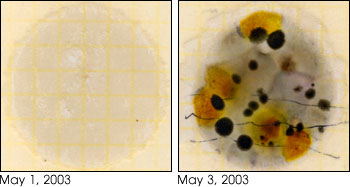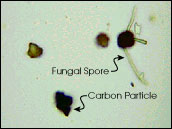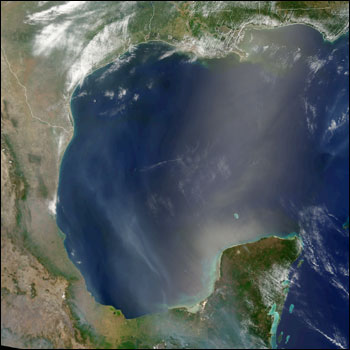

A Smoky Surprise |
|||
Since disease-causing bacteria and fungi have been known to hitch a ride across the Atlantic on Saharan Dust particles (they have probably played a role in the decline of Caribbean coral reefs over the past two decades), Mims decided to see whether she might be able to find bacteria or fungal spores along with dust from Asian deserts that sometimes reaches Texas in the spring. In the spring of 2002, she set out her microscope slides along with Petrifilms—strips of gel and nutrients that can be used to grow microorganisms like bacteria and mold. “The strips come dry, and you have to squirt them with water before you expose them to the air. Once you set them out in the air for 15 minutes, you cover them up with a clear sheet of plastic, and after a few days, if you caught anything, you’ll see stuff starting to grow,” says Mims. |
|||
 |
Sarah Mims exposed Petrifilms outside of her Texas home in April and May of 2002, expecting to find micro-organisms carried by Asian dust. Instead, colonies of bacteria and mold (right) grew on days when the air was filled with smoke, not dust. (Digital Scans by Sarah A. Mims) | ||
The technique was a success. Within a few days, Mims’ gel strips were practically a jungle of different colored splotches, each one a separate fungal colony. Large numbers of spores were also visible on the microscope slides she had exposed to the air almost every day between April 25 and May 17. There was just one problem, at least from her “Asian-dust-carrying-microbes” hypothesis: the slides didn’t show any Asian dust! “There were a lot of fungal spores that I could identify on the slides,” says Mims,“even at the beginning of the period. But there really wasn’t much dust.” What she did see on the slides was a lot of black carbon particles, in other words, soot. To help solve the puzzle, Mims turned to satellite images. Observations from the Sea-viewing Wide Field-of-View Sensor (SeaWiFS) during that time showed huge plumes of smoke from forest fires in southern Mexico and Central America crossing the Gulf of Mexico and blowing over Texas. Could the Central American smoke be bringing the fungal spores with it? |
 Under the microscope Mims found fungal spores along with chunks of black carbon—individual particles of smoke. Once she knew the micro-organisms were associated with smoke, not dust, she needed to find their source. (Micrograph by Sarah A. Mims) Under the microscope Mims found fungal spores along with chunks of black carbon—individual particles of smoke. Once she knew the micro-organisms were associated with smoke, not dust, she needed to find their source. (Micrograph by Sarah A. Mims) | ||

“I counted the number of spores and the number of carbon particles on the slides,” explains Mims. “If the spores were coming from fungus that lived in our area, then there shouldn’t be any relationship between the amount of black carbon soot and the number of fungal spores.” Instead what Mims found was that when the number or carbon particles went up, the number of certain kinds of spores—but not all of them—went up, too. This is exactly what you would expect to see if some of the spores came from local sources and some came along with the smoke. It certainly seemed that the airborne fungus was related to the Central American smoke. |
Satellite images from the days Mims conducted her experiments revealed smoke from fires in Central America flowing over the Gulf of Mexico and into the Texas sky. Blue-gray smoke stretches from the bottom center of the image toward Texas at the upper left. The bright region extending towards the top of the image from the Yucatan Peninsula is the sun glinting off the ocean’s surface. This image was acquired by the Moderate Resolution Imaging Spectroradiometer (MODIS) on the morning of May 2, 2002. (Image by Mark Gray, GSFC) | ||

As a final demonstration that smoke can harbor fungal spores, Mims set fire to several different kinds of organic material and held Petrifilms out in the smoke to collect any spores that might be released. Smoke from fires made from live grass, dead grass, flood debris, dry leaves, dry twigs and even newspaper released fungal spores that colonized the Petrifilms. Each sample showed lots more fungal growth than the reference films—films exposed to plain air—taken before, after, and in between each of the experimental burns. Clearly, fires don’t destroy all kinds of fungal spores, and those spores can be released in a fire’s smoke. |
Mims confirmed that micro-organisms could survive in smoke with a backyard experiment. She burned piles of brush and debris, and exposed Petrifilms to the smoke. Sure enough, mold and bacteria grew on the films. (Photograph by Forrest M. Mims III) |